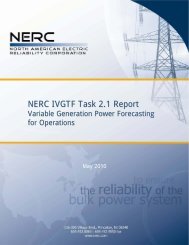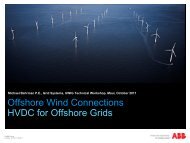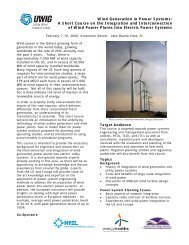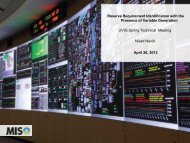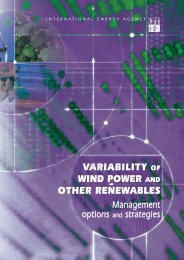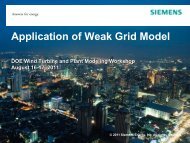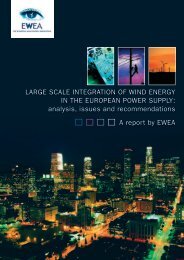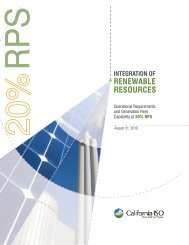Integrating Southwest Power Pool Wind to Southeast Electricity ...
Integrating Southwest Power Pool Wind to Southeast Electricity ...
Integrating Southwest Power Pool Wind to Southeast Electricity ...
You also want an ePaper? Increase the reach of your titles
YUMPU automatically turns print PDFs into web optimized ePapers that Google loves.
Table 5-10 shows the difference in generation between scenarios #3 and #2. As shown earlier,<br />
coal output from across the footprint increases significantly displacing primarily TVA and SBA<br />
CC output. This occurs because the lower reserve requirement across the footprint results in<br />
less need for CCs <strong>to</strong> be online and spinning and because the other SERC regions not assigned<br />
wind (SERC West and SERC East) can now also provide reserve <strong>to</strong> balance the intra hour<br />
variability of the wind from their cheapest generation.<br />
Entergy’s generation contribution does not change significantly, but TVA and SBA decrease<br />
generation corresponding <strong>to</strong> their CC decrease being greater than coal increase. SPP increases<br />
generation due <strong>to</strong> its coal, while coal increases also account for an increase in other Western and<br />
Eastern SERC regions. The net effect of this is a decrease in production costs of approximately<br />
$0.7/MWh.<br />
Figure 5-10 shows the net effect of the changes in Scenario 2 vs. Scenario 1. Entergy stays much<br />
the same, while SPP and the SERC East and SERC West regions with no wind assigned increase<br />
and TVA and SBA decrease generation. This results in the <strong>to</strong>tal cost reduction, as the cheaper<br />
coal generation from across the footprint can be used instead of CCs in TVA and SBA.<br />
Figure 5-10: Net effect of Scenario 3 vs. Scenario 2 - blue indicates increase in generation<br />
Figures Figure 5-11 and Figure 5-12 show the aggregate footprint wide generation stack dispatch<br />
for a selected week in April for Scenarios 2 and 3. This week was picked as it had high wind<br />
variability and relatively low load, and therefore should show times when the benefits of closer<br />
coordination can be seen.<br />
5-17




